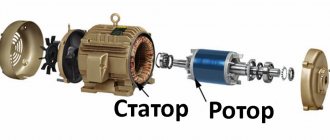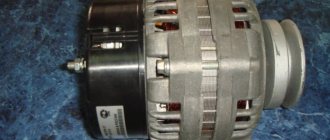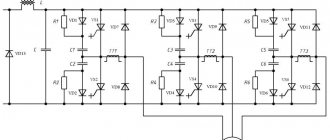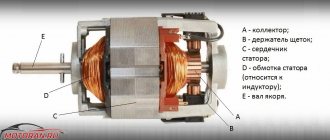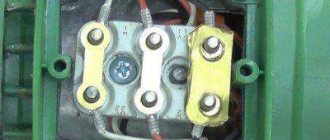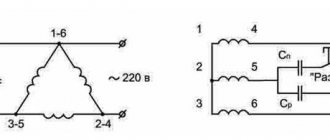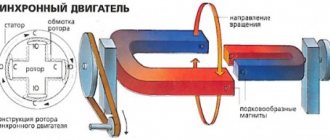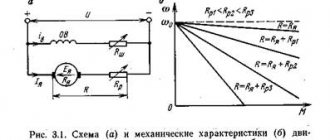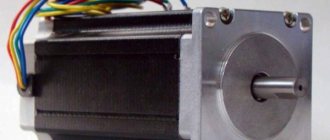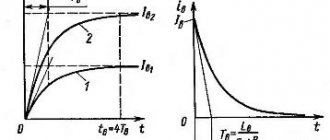Operating principle and connection of a single-phase 220V electric motor
A single-phase motor operates using alternating electric current and is connected to single-phase networks. The network must have a voltage of 220 Volts and a frequency of 50 Hertz.
Electric motors of this type are used mainly in low-power devices:
Models are available with power from 5 W to 10 kW.
The values of efficiency, power and starting torque for single-phase motors are significantly lower than for three-phase devices of the same size. The overload capacity is also higher for 3-phase motors. Thus, the power of a single-phase mechanism does not exceed 70% of the power of a three-phase mechanism of the same size.
- Actually has 2 phases. but only one of them does the work, so the motor is called single-phase.
- Like all electric machines. A single-phase motor consists of 2 parts: stationary (stator) and moving (rotor).
- It is an asynchronous electric motor. on the stationary component of which there is one working winding, connected to a single-phase alternating current source.
The strengths of this type of engine include the simplicity of the design, which is a rotor with a squirrel-cage winding. The disadvantages are low starting torque and efficiency.
The main disadvantage of single-phase current is its inability to generate a magnetic field that performs rotation. Therefore, a single-phase electric motor will not start on its own when connected to the network.
In the theory of electrical machines, the rule applies: in order for a magnetic field to arise that rotates the rotor, there must be at least 2 windings (phases) on the stator. It is also required to shift one winding by a certain angle relative to the other.
During operation, alternating electric fields flow around the windings:
- According to this. The so-called starting winding is located on the stationary section of the single-phase motor. It is shifted 90 degrees relative to the working winding.
- A current shift can be obtained by including a phase-shifting link in the circuit. Active resistors, inductors and capacitors can be used for this.
- 2212 electrical steel is used as the basis for the stator and rotor.
It is incorrect to call single-phase electric motors that are 2- and 3-phase in structure, but are connected to a single-phase power source through matching circuits (capacitor electric motors). Both phases of such devices are working and are turned on all the time.
Single-phase capacitor start/capacitor run (CSCR) motor
This type of motor, called CSCR motor for short, combines the best properties of a capacitor-started induction motor and a permanent capacitor-started motor. Although their design makes these motors slightly more expensive than other single-phase motors, they remain the best option for demanding applications. The starting capacitor of the CSCR electric motor is connected in series with the starting winding, as in a capacitor starting electric motor. This provides high starting torque.
CSCR motors are also similar to permanent split capacitance (PSC) motors in that they also start via a capacitor, which is connected in series with the starting winding if the starting capacitor is disconnected from the mains. This means that the engine is coping with maximum load or overload.
CSCR motors can be used to operate at low full load current and at higher efficiency. This offers several benefits, including allowing the motor to operate with less temperature fluctuations than other similar single-phase motors.
CSCR motors are the most powerful single-phase motors available and can be used in demanding applications such as high pressure water pumps, vacuum pumps and other high torque applications. The output power of such electric motors ranges from 1.1 to 11 kW.
Main types of single-phase induction motors
Household appliances and low-power devices operate on single-phase alternating current; in addition, three-phase power supply cannot be provided everywhere. Therefore, single-phase AC motors have become widespread, especially in the USA. AC motors are often preferred due to their robust design, low cost, and maintenance-free operation.
As the name suggests, a single-phase induction motor operates on the principle of induction; the same principle applies to three-phase electric motors. However, there are differences between them: single-phase electric motors, as a rule, operate at alternating current and voltage 110 -240 V, the stator field of these motors does not rotate. Instead, each time the sinusoidal voltage jumps from negative to positive, the poles change.
In single-phase electric motors, the stator field is constantly aligned in one direction, and the poles change their position once in each cycle. This means that a single-phase induction motor cannot be started on its own.
In theory, a single-phase electric motor could be started by mechanically rotating the motor and then immediately applying power. However, in practice, all electric motors start automatically.
There are four main types of electric motors:
• induction motor with capacitor start / winding operation (inductance) (CSIR),
• induction motor with capacitor start/capacitor operation (CSCR),
• rheostatic starting induction motor (RSIR) and
• permanent split capacitance (PSC) motor.
The figure below shows typical torque/speed curves for the four main types of single-phase AC motors.
Single-phase capacitor-start/inductive-run (CSIR) motor
Capacitor start induction motors, also known as CSIR motors, form the largest group of single-phase electric motors.
CSIR motors are available in several sizes: from the lowest power to 1.1 kW. In CSIR motors, the capacitor is connected in series with the starting winding. The capacitor causes some lag between the current in the starting winding and the current in the main winding.
This contributes to a delay in the magnetization of the starting winding, which leads to the appearance of a rotating field, which affects the occurrence of torque. After the electric motor picks up speed and approaches the operating speed, the starter opens. Next, the electric motor will operate in the usual mode for an induction electric motor. The starter can be centrifugal or electronic.
CSIR motors have relatively high starting torque, ranging from 50 to 250 percent of full load torque. Therefore, of all single-phase electric motors, these motors are best suited for applications where starting loads are high, such as conveyors, air compressors and refrigeration compressors.
How to connect a 220V asynchronous motor
Since the supply voltages for different consumers may differ from each other, there is a need to reconnect electrical equipment. Making the connection of a 220-volt asynchronous motor safe for further operation of the equipment is quite simple if you follow the proposed instructions.
In fact, this is not an impossible task. In short, all we need is to connect the windings correctly. There are two main types of asynchronous motors: three-phase with a star-delta winding, and motors with a starting winding (single-phase). The latter are used, for example, in Soviet-designed washing machines. Their model is AVE-071-4C. Let's look at each option in turn.
- Three-phase
- Switch to desired voltage Increase voltage
- Voltage reduction
Capacitor motors - device, principle of operation, application
In this article we will talk about capacitor motors, which are essentially ordinary asynchronous motors, differing only in the way they are connected to the network.
Let's touch on the topic of selecting capacitors and analyze the reasons for the need for precise selection of capacitance. Let us note the basic formulas that will help in approximately estimating the required capacity. A capacitor motor is an asynchronous motor in which additional capacitance is included in the stator circuit in order to create a phase shift of the current in the stator windings. This often concerns single-phase circuits when using three-phase or two-phase asynchronous motors.
The stator windings of an asynchronous motor are physically shifted relative to each other, and one of them is connected directly to the network, while the second, or the second and third, are connected to the network through a capacitor. The capacitance of the capacitor is selected so that the phase shift of the currents between the windings is equal to or at least close to 90°, then the rotor will be provided with maximum torque.
In this case, the magnetic induction modules of the windings must be the same, so that the magnetic fields of the stator windings are shifted relative to each other so that the total field rotates in a circle, and not in an ellipse, dragging the rotor along with it with the greatest efficiency.
Obviously, the current and its phase in the winding connected through the capacitor are related both to the capacitance of the capacitor and to the effective impedance of the winding, which in turn depends on the speed of rotation of the rotor.
When the motor starts, the impedance of the winding is determined only by its inductance and active resistance, so it is relatively small at the moment of starting, and a larger capacitor is needed here to ensure optimal starting.
When the rotor accelerates to rated speed, the magnetic field of the rotor will begin to induce an EMF in the stator windings, which will be directed against the voltage supplying the winding - the effective resistance of the winding now increases, and the required capacitance decreases.
With an optimally selected capacitance in each mode (start-up mode, operating mode), the magnetic field will be circular, and here both the rotor rotation speed, the voltage, the number of turns of the winding, and the currently connected capacitance matter. If the optimal value of any parameter is violated, the field becomes elliptical, and engine performance decreases accordingly.
For engines for different purposes, the tank connection diagrams are different. When a significant starting torque is required, a larger capacitor is used to ensure optimal current and phase at the exact moment of starting. If the starting torque is not particularly important, then attention is paid only to creating optimal operating conditions, at the rated rotation speed, and the capacity is selected for the rated speed.
Quite often, for a high-quality start, a starting capacitor is used, which for the duration of starting is connected in parallel to a working capacitor of a relatively small capacitance, so that the rotating magnetic field is circular during starting, then the starting capacitor is turned off, and the engine continues to operate only with the working capacitor. In special cases, they resort to a set of capacitors with the ability to switch for different loads.
If the starting capacitor is not accidentally disconnected after the engine reaches rated speed, the phase shift in the windings will decrease, will no longer be optimal, and the stator magnetic field will become elliptical, which will degrade the performance of the engine. It is extremely important to choose the right starting and running tanks for the engine to operate efficiently.
The figure shows typical switching circuits for capacitor motors used in practice. For example, consider a two-phase squirrel-cage motor whose stator has two windings for power supply in two phases A and B.
A capacitor C is included in the additional stator phase circuit, so currents IA and IB flow in both stator windings in two phases. By using the capacitance, a phase shift of the currents IA and IB is achieved by 90°.
The vector diagram shows that the total network current is formed by the geometric sum of the currents of both phases IA and IB. By selecting capacitance C, a combination with the inductances of the windings is achieved so that the phase shift of the currents is exactly 90°.
The current IA lags relative to the applied mains voltage UA by an angle φA, and the current IB lags by an angle φB relative to the voltage UB applied to the terminals of the second winding at the current moment. The angle between the mains voltage and the voltage applied to the second winding is 90°. The voltage across the capacitor UC forms an angle of 90° with the current IB.
The diagram shows that full compensation of the phase shift at φ = 0 is achieved when the reactive power consumed by the motor from the network is equal to the reactive power of capacitor C. The figure next to it shows typical circuits for connecting three-phase motors with capacitors in the stator winding circuits.
The industry today produces capacitor motors based on two-phase motors. Three-phase ones can be easily modified manually to be powered from a single-phase network. There are also small-scale three-phase modifications, already optimized with a capacitor for a single-phase network.
Often such solutions can be found in household appliances such as dishwashers and room fans. Industrial circulation pumps, blowers and smoke exhausters also often use capacitor motors in their operation. If you need to connect a three-phase motor to a single-phase network, use a phase-shifting capacitor, that is, again convert the motor into a capacitor one.
To approximately calculate the capacitance of the capacitor, well-known formulas are used, into which it is enough to substitute the supply voltage and operating current of the motor, and it is easy to calculate the required capacitance for connecting the windings with a star or triangle.
To find the operating current of the motor, just read the data on its nameplate (power, efficiency, cosine phi), and also substitute it into the formula. As a starting capacitor, it is customary to install a capacitor with twice the capacitance of the working capacitor.
The advantages of capacitor motors, essentially asynchronous ones, include mainly one thing - the ability to connect a three-phase motor to a single-phase network. The disadvantages are the need for optimal capacity for a specific load, and the inadmissibility of power supply from inverters with a modified sine wave.
We hope that this article was useful to you, and now you understand why capacitors are used in asynchronous motors and how to select their capacitance.
Source: electricalschool.info
Single-phase motors are low-power electrical machines. The magnetic circuit of single-phase motors contains a two-phase winding, consisting of a main winding and a starting winding.
Two windings are needed to cause the rotor of a single-phase motor to rotate. The most common motors of this type can be divided into two groups: single-phase motors with a starting winding and motors with a running capacitor.
For engines of the first type, the starting winding is switched on through a capacitor only at the time of start-up and after the engine has developed a normal rotation speed, it is disconnected from the network. The motor continues to operate with one working winding. The size of the capacitor is usually indicated on the motor nameplate and depends on its design.
For single-phase asynchronous AC motors with a running capacitor, the auxiliary winding is permanently connected through a capacitor. The value of the working capacitance of the capacitor is determined by the design of the engine.
That is, if the auxiliary winding of a single-phase motor is starting, its connection will occur only during the start-up, and if the auxiliary winding is a capacitor, then its connection will occur through a capacitor, which remains turned on during engine operation.
Connection diagrams
For those who are a little unfamiliar with how asynchronous electric motors are connected to a three-phase network, I strongly recommend that you read my article Connecting a motor via a magnetic contactor. I assume that the reader knows how the electric motor turns on, why and what kind of motor protection is needed, so in this article I omit these questions.
In theory everything is simple, but in practice you have to rack your brains.
Obviously, turning on the Dahlander motor windings can be done in two ways - through a switch and through contactors.
Changing speeds using a switch
Let's first consider a simpler circuit - through a PKP-25-2 type switch. Moreover, these are the only schematic diagrams that I have come across.
The switch must have three positions, one of which (middle) corresponds to the engine being turned off. About the switch device - a little later.
Connecting a two-speed motor. Diagram on the control panel switch.
Crosses on the dotted lines of the SA1 switch position indicate the closed states of the contacts. That is, in position 1, power from L1, L2, L3 is supplied to the triangle (pins U1, V1, W1). Pins U2, V2, W2 remain unconnected. The engine rotates at the first, reduced speed.
When SA1 is switched to position 2, the pins U1, V1, W1 are connected to each other, and power is supplied to U2, V2, W2.
Switching speeds using contactors
When started using contactors, the circuit will look similar:
Scheme of switching on the motor at different speeds using contactors
Here, the motor turns on the contactor KM1 at the first speed, and KM2 at the second speed. It is obvious that physically KM2 must consist of two contactors, since it is necessary to close five power contacts at once.
Connecting a single-phase asynchronous motor
To accelerate an asynchronous motor, it is necessary to create a rotating magnetic field. This is easily handled by a three-phase power supply, where the phases are shifted relative to each other by 120 degrees. But if we are talking about how to connect a single-phase electric motor, then a problem arises: without a phase shift, the shaft will not begin to rotate.
Inside a single-phase asynchronous motor there are two windings: starting and working. If a phase shift is provided in them, the magnetic field will become rotating. And this is the main condition for starting the electric motor. The phases can be shifted by adding resistance (resistor) or an inductive coil. But the most commonly used capacitors are starting and/or running capacitors.
With starting capacity
In most cases, the circuit only includes a starting capacitor. It is active only when the engine is starting. Therefore, the method is good when the launch promises to be difficult, otherwise the shaft will not be able to accelerate due to the small initial torque. After acceleration, the starting capacitor is turned off and operation continues without it.
The connection diagram for a motor with an auxiliary tank is shown in the figure above. To implement it, you will need a relay or at least one button, which you will press for 3 seconds while starting the motor. The auxiliary capacitor, together with the auxiliary winding, is included in the circuit only for a while.
This arrangement provides optimal starting torque if minor AC surges occur during startup. But there is also a drawback - when operating in nominal mode, the technical characteristics drop. This is due to the shape of the magnetic field of the working winding: it is oval, not circular.
With working capacity
If the start is easy, but the work is hard, then instead of a starting capacitor you will need a working capacitor. The connection diagram is shown below. The peculiarity is that the working capacitance, together with the working winding, is constantly connected to the circuit.
The circuit provides good performance when operating in nominal mode.
With both capacitors
A compromise solution is to use auxiliary and working tanks simultaneously. This method is ideal if the AC motor is already started with a load, and the work itself is difficult for it. Look, the diagram below is like two diagrams (with working and auxiliary capacitance) superimposed on each other. When starting, the trigger will be turned on for a few seconds, and the second drive will be active all the time: from start to shutdown.
Capacity calculation
The greatest difficulty for beginners is calculating the capacitance of capacitors. Professionals select them empirically, listening to the engine during startup and operation. This is how they determine whether the drive is suitable or whether they need to look for another one. But with a small error in most cases, the capacity can be calculated as follows:
- For a working drive: 0.7-0.8 µF per 1000 watts of electric motor power;
- For the starting capacitor: 2.5 times more.
Example: you have a 2 kW asynchronous single-phase electric motor. This is 2000 watts. This means that when connecting with a working capacitance, you need to stock up on a 1.4-1.6 µF drive. For the starting one you will need 3.5-4 uF.
Single-phase permanent split capacitance (PSC) motor
As the name suggests, permanent split capacitance (PSC) motors are equipped with a capacitor that is constantly on during operation and connected in series with the starting winding. This means that these motors do not have a starter or capacitor that is used only for starting. Thus, the starting winding becomes an auxiliary winding when the motor reaches operating speed.
PSC motors are designed such that they cannot provide the same starting torque as motors with starting capacitors. Their starting torques are quite low: 30-90% of the rated load, so they are not used in systems with a large starting load. This is compensated by low starting currents - typically less than 200% of rated load current - making them the most suitable motor for long duty cycle applications.
Motors with permanent capacity division have a number of advantages. The operating parameters and speed of such motors can be adjusted to suit the application, and they can be manufactured for optimum efficiency and high power factor at rated load. Since they do not require a special starting device, they can be easily reversed (change the direction of rotation to the opposite). In addition to all of the above, they are the most reliable of all single-phase electric motors. That's why Grundfos uses single-phase PSC motors as standard for all applications with powers up to 2.2 kW (2-pole) or 1.5 kW (4-pole).
Continuously split capacity motors can be used for a number of different applications depending on their design. A typical example is low inertia loads such as fans and pumps.
Connecting a single-phase synchronous electric motor
Despite the complexity of the design of synchronous motors, they have many advantages over asynchronous ones. The main thing is the low sensitivity to voltage surges leading to a sharp decrease or increase in current. No less significant is the fact that synchronous motors can operate even with overload, not to mention the optimal mode of reactive energy and shaft rotation at a constant speed. However, connecting is a labor-intensive process, and this is already a disadvantage.
Overclocking method
You cannot start a single-phase synchronous motor by simply applying power to its windings. Because at the moment of switching on, the direction of the supply current in the stator windings corresponds to figure (a). At this time, a pair of forces acts on the rotor, which is still at rest, which will try to rotate the shaft clockwise. But after half the period in the stator windings, the current will change its direction. Therefore, a pair of forces will already act in the opposite direction, turning the shaft counterclockwise, as in figure (b). Since the rotor has great inertia, it will never move.
To make the rotor rotate, it is necessary that it has time to make at least half a revolution so that a change in the direction of the current does not affect its rotation. This is possible if the shaft is accelerated with the help of outside forces. This can be done in two ways:
- Manually;
- Using a second engine.
Only low-power synchronous electric motors can be accelerated with your own hand strength. And for medium- and high-power units you will have to use a different motor.
When accelerating with an external force, the rotor begins to rotate at a speed close to synchronous. Then only the excitation winding turns on, and then the stator winding.
Asynchronous start of a synchronous motor
If metal rods are placed in the tips on the rotor poles, and they are connected to each other on the sides by rings, then the motor must be started asynchronously. These rods play the role of an auxiliary winding that an asynchronous motor has. In this case, the excitation winding is short-circuited using a discharge resistor, and the stator winding is connected to the network. This is the only way to achieve the same acceleration as an asynchronous electric motor. But after the rotation speed is as close as possible to synchronous (95% of it is enough), the excitation winding is connected to a direct current source. The speed becomes completely synchronous, which entails a decrease in the induced emf of the auxiliary winding down to zero. And it turns off automatically.
The layout and method of connecting your motor will depend on whether you have a synchronous or asynchronous motor. The power of the motor is also taken into account, as well as the starting method: with or without load. A basic understanding of mechanics and electromagnetic phenomena will help you understand the drawings.
How does a single-phase electric motor work?
Structurally, the electric motor, designed for use on a domestic, non-industrial scale, is not much different from its “brothers” (except perhaps in size) and has the same elements:
- Frame;
- Stator (windings + core);
- Rotor;
- Shaft with keyways at front and fan at rear;
- Sealed covers with bearings;
- Terminal box.
- Induction starting device.
The rotor has short-circuited turns. Like the stator core, its housing is made of high quality electrical steel.
Looking at the photo, you can see that a commutator single-phase electric motor differs from an asynchronous one in the rectangular shape of the housing and the presence of graphite-copper brushes.
The current collector located on the shaft is hidden by a casing. Therefore, it is possible to identify that this is an electric motor of a different type by the brushes, which are visible and pressed against the commutator rings by springs.
Its structure is slightly different from a conventional single-phase asynchronous motor. The principle of operation is the same. Voltage is supplied to the brushes, and through them to the armature, which rotates the shaft in the bearings. In asynchronous systems it’s the other way around: the magnetic field of the stator rotates the rotor!
The rotation speed can be adjusted using a special device - a rheostat. While the asynchronous motor operates within the maximum speed, which is difficult, sometimes impossible, to control smoothly, without jerking - reduce, increase after acceleration.
Basic connection diagrams
As a phase-substituting element for connecting a single-phase asynchronous motor, you can use various electromechanical elements (inductor, active resistor, etc.), but a capacitor provides the best starting effect, which is why it is used for this most often.
single phase asynchronous motor and capacitor
There are three main ways to start a single-phase asynchronous motor through:
- worker;
- launcher;
- working and starting capacitor.
In most cases, a circuit with a starting capacitor is used. This is due to the fact that it is used as a starter and only works when the engine is turned on. Further rotation of the rotor is ensured by the pulsating magnetic field of the working phase, as already described in the previous paragraph. A relay or button is often used to complete the trigger circuit.
Since the starting phase winding is used for a short time, it is not designed for heavy loads and is made of thinner wire. To prevent its failure, a thermal relay (opens the circuit after heating to the set temperature) or a centrifugal switch (turns off the starting winding after acceleration of the motor shaft) is included in the motor design.
In this way, excellent starting characteristics are achieved. However, this scheme has one significant drawback - the magnetic field inside a motor connected to a single-phase network is not circular, but elliptical. This increases losses during the conversion of electrical energy into mechanical energy and, as a result, reduces efficiency.
The circuit with a working capacitor does not provide for disconnecting the additional winding after starting and accelerating the engine. In this case, the capacitor allows you to compensate for energy losses, which leads to a natural increase in efficiency. However, in favor of efficiency, starting characteristics are sacrificed.
For the circuit to operate, it is necessary to select an element with a certain capacity, calculated taking into account the load current. An unsuitable capacitor will cause the rotating magnetic field to take on an elliptical shape.
A kind of “golden mean” is a connection diagram using both capacitors - both starting and working. When connecting the engine in this way, its starting and operating characteristics take average values relative to the circuits described above.
In practice, for devices that require the creation of a strong starting torque, the first circuit with a corresponding capacitor is used, and in the opposite situation, the second, with a working one.
Direction of rotation
In some cases, when the engine is turned on, the shaft begins to rotate in the wrong direction. To solve this problem, you will have to change the position of the leads in the place where one was connected to the switch, and the other to the end of the working winding.
Shaft rotation in both directions can be ensured by installing a reverse toggle switch. It must have two or three working positions and six terminals. When installing such a toggle switch on a capacitor motor, it is necessary to provide for the possibility of switching it while the motor is running. The central terminals need to be connected to the wires of one of the windings, the outer terminals must be connected diagonally and two wires removed. Connect the removed wires to the places where the ends of the winding were located. After this, the motor will spin in both directions.
How to connect
You can connect a single-phase electric motor to a power outlet using special connectors - a plug. It is necessary to have a voltage of 220 - 240 V and a current frequency of 50 Hz. Regardless of what kind of device it is - a juicer, mixer, electric meat grinder or vacuum cleaner, the connectors of the connected electrical appliance and sockets always match!
The electric motor can be started using a capacitor of the correct capacity, connected to the starting winding, or using a resistor.
Usually all this is already provided for in the design. Just “plug the plug into the socket” and press the “start” button.
At the same time, the trigger mechanism can operate either briefly or be permanently connected to the circuit.
Thus, when choosing a purposeful “motor” for a single-phase network, it is important to start it correctly. Household appliances already have the necessary settings, just press a button
In other cases, you need to choose the right starting device so that the engine starts and performs its assigned tasks.
Launch
Single-phase current is unable to create an eddy magnetic field. This requires two windings, one of which is offset relative to the other. Therefore, it will not be possible to start the electric motor simply by connecting it to a 220 V network.
We need an initial push. You can, of course, mechanically unwind the shaft and turn it on. But it's not necessary. Everything happens automatically with the help of special design features that allow phase-shifting devices of capacitive or inductive type to be included in the circuit.
Electric motors: design and principle of operation- Electric motor rotor - design features and operating principle of the device. Repair and restoration instructions
Connecting an electric motor - basic diagrams, methods and features of connecting various models (instructions + photos)
The engine actually has two phases, one of which is starting, the other is working.
The winding that gives the initial push is located on the stationary part of the unit and is shifted relative to the other by ninety degrees, which allows you to start the working winding and create a full-fledged vortex electromagnetic field in the stator, rotating the shaft with the rotor mounted on it.
There is a certain scheme for connecting and starting a single-phase electric motor:
- The magnetic field that rotates the rotor (armature) is created by the main and additional windings;
- In order for the engine to start working, you need to hold the start button until the rotor accelerates;
- At this time, the electric motor operates in two-phase mode.
- It is important not to hold the trigger mechanism for a long time (immediately release it as soon as the rotor starts) so that the field winding does not overheat from being under load for a long time.
To protect the engine from overheating and untimely switching off the voltage to the starting winding, a thermal relay and a centrifugal switch are used. They de-energize the entire electrical installation when it overheats or one of the phases when the rotor has accelerated and there is no need to supply voltage.
Connection
To operate the device, 1 phase with a voltage of 220 Volts is required. This means that you can plug it into a household outlet. This is precisely the reason for the popularity of the engine among the population. All household appliances, from a juicer to a grinder, have mechanisms of this type.
connection with starting and running capacitors
There are 2 types of electric motors: with a starting winding and with a working capacitor:
- In the first type of devices. The starting winding operates via a capacitor only during start-up. Once the machine reaches normal speed, it turns off and operation continues with one winding.
- In the second case. for motors with a working capacitor, the additional winding is permanently connected through the capacitor.
An electric motor can be taken from one device and connected to another. For example, a working single-phase motor from a washing machine or vacuum cleaner can be used to operate a lawn mower, processing machine, etc.
There are 3 schemes for switching on a single-phase motor:
- In 1 scheme. The work of the starting winding is performed by means of a capacitor and only for the start-up period.
- 2 circuit also provides for a short-term connection, but it occurs through a resistance and not through a capacitor.
- Scheme 3 is the most common. In this scheme, the capacitor is constantly connected to a source of electricity, and not just during startup.
Connecting an electric motor with starting resistance:
- The auxiliary winding of such devices has increased active resistance.
- To start an electrical machine of this type, a starting resistor can be used. It should be connected in series to the starting winding. Thus, it is possible to obtain a phase shift of 30° between the winding currents, which will be quite enough to start the mechanism.
- Besides. a phase shift can be obtained by using a starting phase with a higher resistance value and a lower inductance value. This winding has fewer turns and thinner wire.
Connecting a motor with capacitor start:
- For these electric machines, the starting circuit contains a capacitor and is turned on only for the start period.
- To achieve the maximum starting torque, a circular magnetic field is required that performs the rotation. For it to occur, the winding currents must be rotated 90° relative to each other. Phase-shifting elements such as a resistor and inductor do not provide the necessary phase shift. Only the inclusion of a capacitor in the circuit allows you to obtain a phase shift of 90°, if you select the capacitance correctly.
- Calculate. Which wires belong to which winding can be determined by measuring the resistance. For the working winding, its value is always less (about 12 Ohms) than for the starting winding (usually about 30 Ohms). Accordingly, the cross-section of the working winding wire is larger than that of the starting winding.
- The capacitor is selected according to the current consumed by the motor. For example, if the current is 1.4 A, then a capacitor with a capacity of 6 μF is required.
Brushed motors
In addition to asynchronous ones, some electrical appliances may have commutator motors that have design differences. Mandatory elements of their design are special brushes and a copper drum divided into sections. The advantage of motors of this type is the large number of revolutions at the time of start and after acceleration. The direction of movement of the shaft in them is regulated by changing the polarity.
Also in such electric motors the rotation speed can be changed. This property allows the use of commutator motors in various household and construction equipment. Their disadvantage is considered to be the loud noise produced during operation. Asynchronous ones operate with less noise.
Operating principle
The principle of operation of an electric motor demonstrates the simplest experiment that we were all shown at school - the rotation of a frame with current in the field of a permanent magnet.
The frame with current is an analogue of the rotor, the stationary magnet is the stator. If current is applied to the frame, it will turn perpendicular to the direction of the magnetic field and freeze in this position. If you force the magnet to spin, the frame will rotate at the same speed, that is, synchronously with the magnet. We have a synchronous electric motor. But our magnet is a stator, and by definition it is motionless. How to make the magnetic field of a stationary stator rotate?
First, let's replace the permanent magnet with a current-carrying coil. This is the winding of our stator. As is known from the same school physics, a coil with current creates a magnetic field. The latter is proportional to the magnitude of the current, and the polarity depends on the direction of the current in the coil. If we apply alternating current to the coil, we get an alternating field.
A very clear analogy with a clock will help us. What vectors constantly rotate before our eyes? These are the hour hands. Let's imagine that there is a clock hanging in the corner of the room. The second hand rotates one full revolution per minute. An arrow is a vector of unit length.
The shadow that the arrow casts on the wall varies as a sine with a period of 1 minute, and the shadow cast on the floor changes as a cosine. Or a sine phase shifted by 90 degrees. But a vector is equal to the sum of its projections. In other words, the arrow is equal to the vector sum of its shadows.
Connection diagrams for single-phase asynchronous motors
With starting winding
To connect a motor with a starting winding, you will need a button in which one of the contacts opens after switching on. These opening contacts will need to be connected to the starting winding. In stores there is such a button - this is PNDS. Its middle contact closes for the holding time, and the two outer ones remain in a closed state.
Appearance of the PNVS button and the state of the contacts after the “start” button is released"
First, using measurements, we determine which winding is working and which is starting. Typically the output from the motor has three or four wires.
Consider the option with three wires. In this case, the two windings are already combined, that is, one of the wires is common. We take a tester and measure the resistance between all three pairs. The working one has the lowest resistance, the average value is the starting winding, and the highest is the common output (the resistance of two windings connected in series is measured).
If there are four pins, they ring in pairs. Find two pairs. The one with less resistance is the working one, the one with more resistance is the starting one. After this, we connect one wire from the starting and working windings, and bring out the common wire. A total of three wires remain (as in the first option):
- one from the working winding is working;
- from the starting winding;
- general.
We work further with these three wires - we use them to connect a single-phase motor.
With all these
- Connecting a single-phase motor with a starting winding via the PNVS button
connecting a single-phase motor
We connect all three wires to the button. It also has three contacts. Be sure to place the starting wire on the middle contact (which closes only during the start), the other two - on the outer ones (arbitrarily)
We connect a power cable (from 220 V) to the extreme input contacts of the PVNS, connect the middle contact with a jumper to the working one (note! not to the common one). That's the whole circuit for switching on a single-phase motor with a starting winding (bifilar) through a button
Condenser
When connecting a single-phase capacitor motor, there are options: there are three connection diagrams and all with capacitors. Without them, the engine hums, but does not start (if you connect it according to the diagram described above).
Connection diagrams for a single-phase capacitor motor
The first circuit - with a capacitor in the power supply circuit of the starting winding - starts well, but during operation the power it produces is far from rated, but much lower. The connection circuit with a capacitor in the connection circuit of the working winding gives the opposite effect: not very good performance at start-up, but good performance. Accordingly, the first circuit is used in devices with heavy starting (concrete mixers, for example), and with a working condenser - if good performance characteristics are needed.
Circuit with two capacitors
There is a third option for connecting a single-phase motor (asynchronous) - install both capacitors. It turns out something between the options described above. This scheme is implemented most often. It is in the picture above in the middle or in the photo below in more detail. When organizing this circuit, you also need a PNVS type button, which will connect the capacitor only during the start time, until the motor “accelerates”. Then two windings will remain connected, with the auxiliary winding through a capacitor.
Connecting a single-phase motor: circuit with two capacitors - working and starting
When implementing other circuits - with one capacitor - you will need a regular button, machine or toggle switch. Everything connects there simply.
Selection of capacitors
There is a rather complex formula by which you can calculate the required capacity accurately, but it is quite possible to get by with recommendations that are derived from many experiments:
- The working capacitor is taken at the rate of 70-80 uF per 1 kW of engine power;
- starting - 2-3 times more.
The operating voltage of these capacitors should be 1.5 times higher than the network voltage, that is, for a 220 volt network we take capacitors with an operating voltage of 330 V and higher. To make starting easier, look for a special capacitor for the starting circuit. They have the words Start or Starting in their markings, but you can also use regular ones.
Distinguishing types of single-phase motors in practice
Let's learn how to distinguish a bifilar motor from a capacitor motor. It should be said that the difference is purely nominal. The connection diagram for a single-phase motor is similar. The bifilar winding is not designed to operate continuously. It will interfere and reduce efficiency. Therefore, it is interrupted after a set of revolutions by a start-up relay (inherent in household refrigerators) or by centrifugal switches. It is believed that the starting winding operates for several seconds. According to generally accepted standards, it will launch 30 times per hour, lasting 3 seconds each. Then the coils may overheat (burn out). The reason that limits the starting winding being energized.
The difference is nominal, but professionals note an interesting feature by which they judge whether we have a bifilar or capacitor motor. Auxiliary winding resistance. The nominal value differs from the working one by more than 2 times, most likely the engine is bifilar. Accordingly, the winding is starting. A capacitor motor operates using the services of two coils. Both are constantly under tension.
Single phase asynchronous motor
The test must be carried out carefully; in the absence of thermal fuses and other means of protection, the starting winding may burn out. You will have to unscrew the shaft manually, which is clearly not an easy task. Sometimes it is advisable to connect a single-phase asynchronous motor to a single-phase network using a similar circuit, as was done in previous equipment. An ordinary refrigerator is equipped with a start-up relay, a separate topic of discussion. The parameters of the device are closely related to the type of engine used; mutual replacement is not possible in every case (violation of a simple rule can cause breakdown).
Let us mention it twice: there can be three or four winding terminals. The number is not informative. A pair of thermal fuse contacts is acceptable. Plus the above, including the centrifugal switch. In the case of continuity, the resistance is either low, or vice versa - we fix the gap. By the way, do not forget to test each end of the coil against the body when determining the resistance. Insulation is standard not lower than 20 MOhm. Otherwise, you should think about the presence of a breakdown. We also assume that a three-phase motor with internal star-type winding commutation may have a neutral output to the housing. In this case, the motor requires an indispensable grounding, for which a terminal is provided (but it is more likely that the motor simply failed due to an insulation breakdown).
